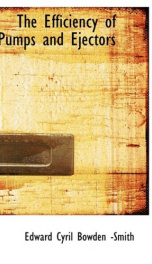the efficiency of pumps and ejectors

Purchase of this book includes free trial access to www.million-books.com where you can read more than a million books for free. This is an OCR edition with typos. Excerpt from book: CHAPTER III MECHANICAL EFFICIENCY OF PUMPS AND EJECTORS Mechanical Efficiency. From the foregoing chapter the importance of knowing the conditions under which a pump or ejector is working 'before drawing comparisons will be understood. We will now examine the mechanical efficiency of the three pumps and multiple ejector system shown on the diagram, Plate XI. To ascertain the efficiencies it is necessary to determine the percentage of the power developed by the engine or motor that is actually converted into useful work. This is accomplished by dividing the pump horse-power by the indicated horsepowerin other words, the work done by the power employed to do it. The essential facts which must be determined to obtain accurate results are : 1. The indicated horse-power. This presents no difficulties, and the usual methods employed are not open to question, therefore the details will not be dealt with here. 2. The pump horse-power. That is the weight of water in pounds lifted per minute, multiplied by the height in feet to which the water is lifted, including frictional head divided by 33,000. In each case these pumps and ejectors are good examples of the type they represent. They are designed and manufactured by well-known makers ; but it is as well to withhold their names, as there is no desire to advertise one or penalise another. They all discharge an effluent from the same source, and it would be difficult to find a more suitable instance for comparison. Efficiency Diagram. The diagram, Plate XI., shows at a glance the initial mean efficiency when the apparatus was first installed and after twelve months' use. The following particulars should be noted. A and B both draw from the same sump. The effluent is gritty, heavily charged with refuse,...
Info about the book
Author:
Series:
Unknown
ASIN:
B003OK7QD2
Rating:
2.5/5 (2)Your rating:
0/5
Languge:
English
Users who have this book
Users who want this book
What readers are saying
What do you think? Write your own comment on this book!
write a commentif you like the efficiency of pumps and ejectors try:
Other books by this author
Do you want to exchange books? It’s EASY!
Get registered and find other users who want to give their favourite books to good hands!


